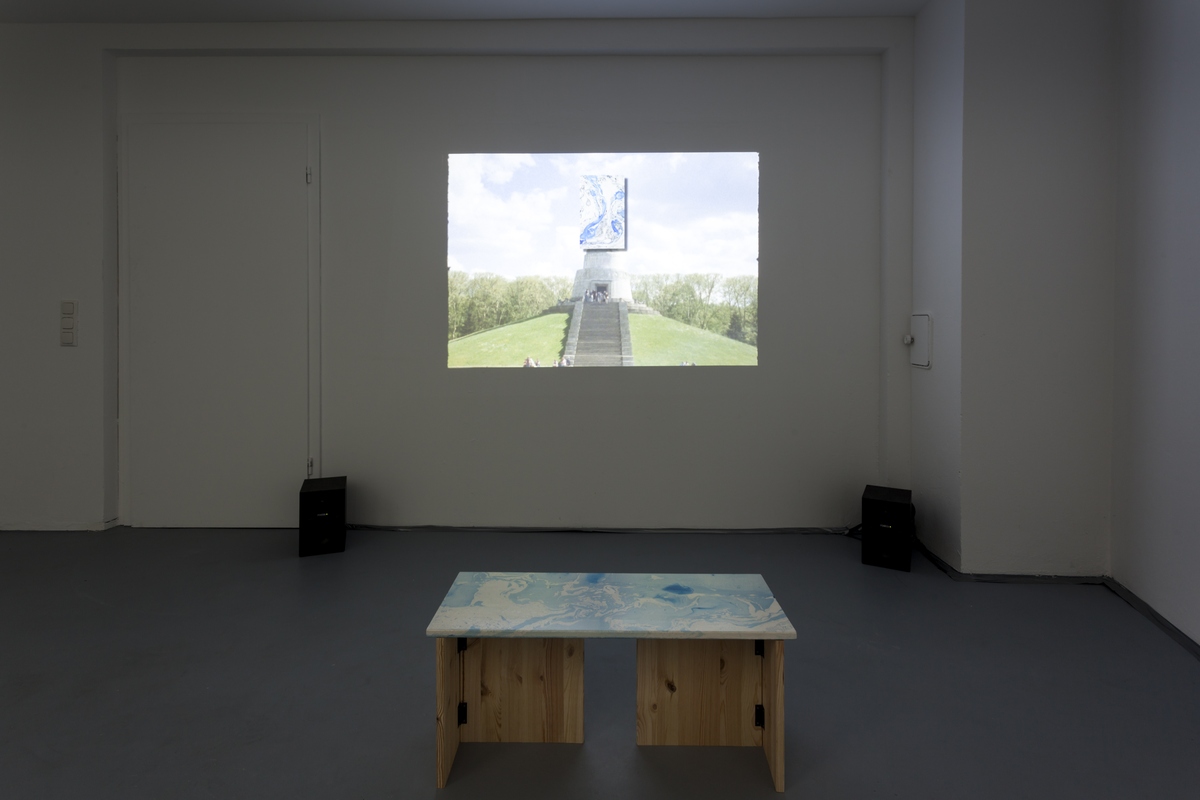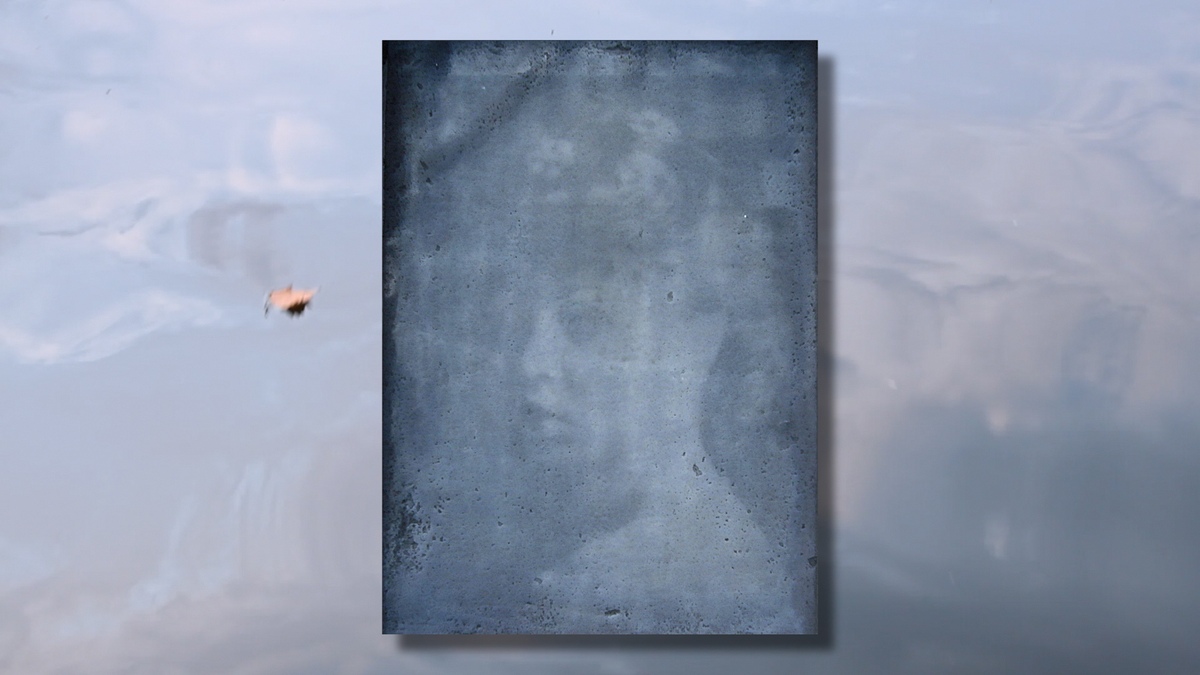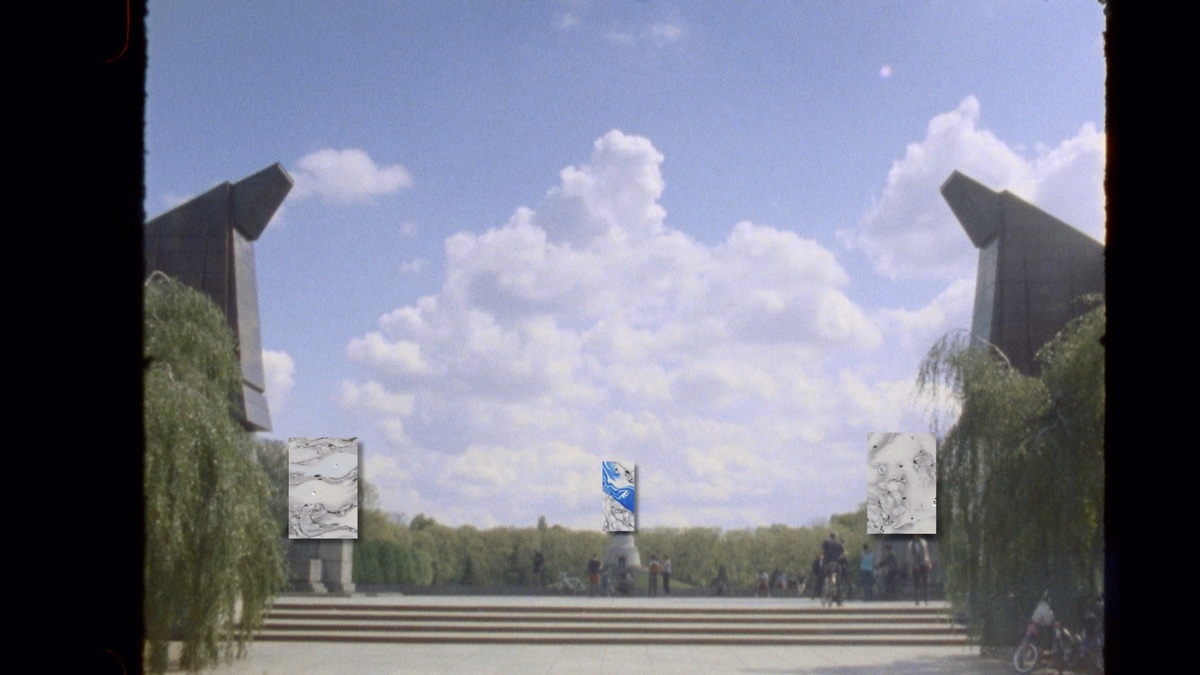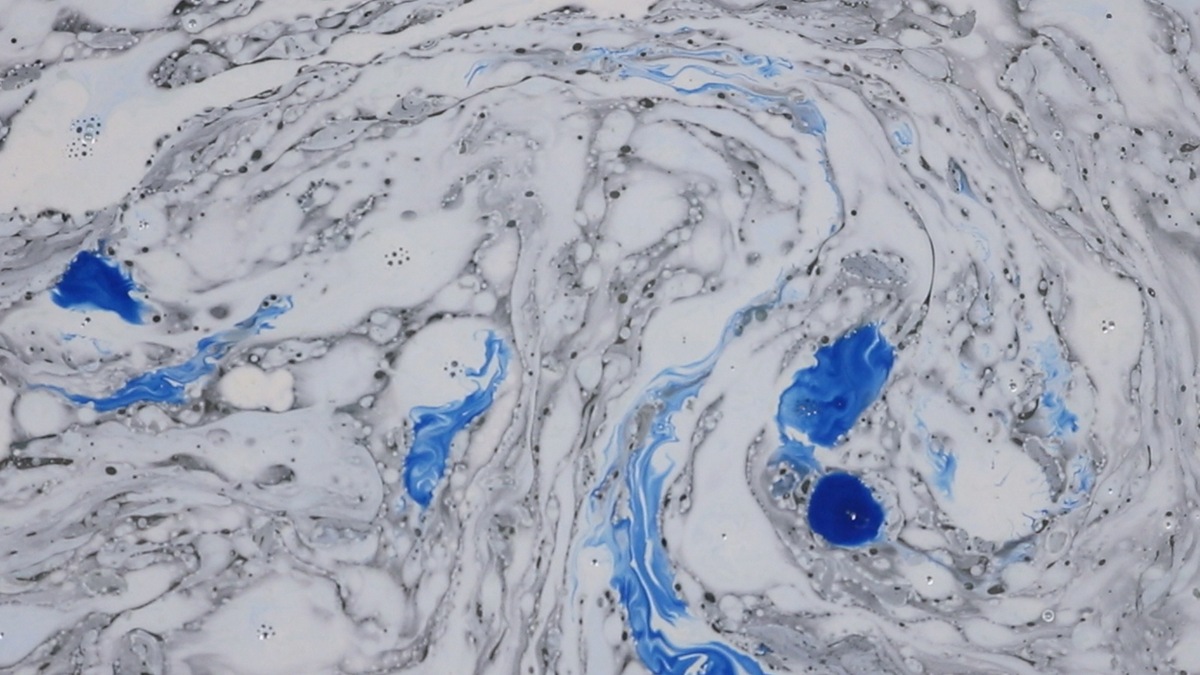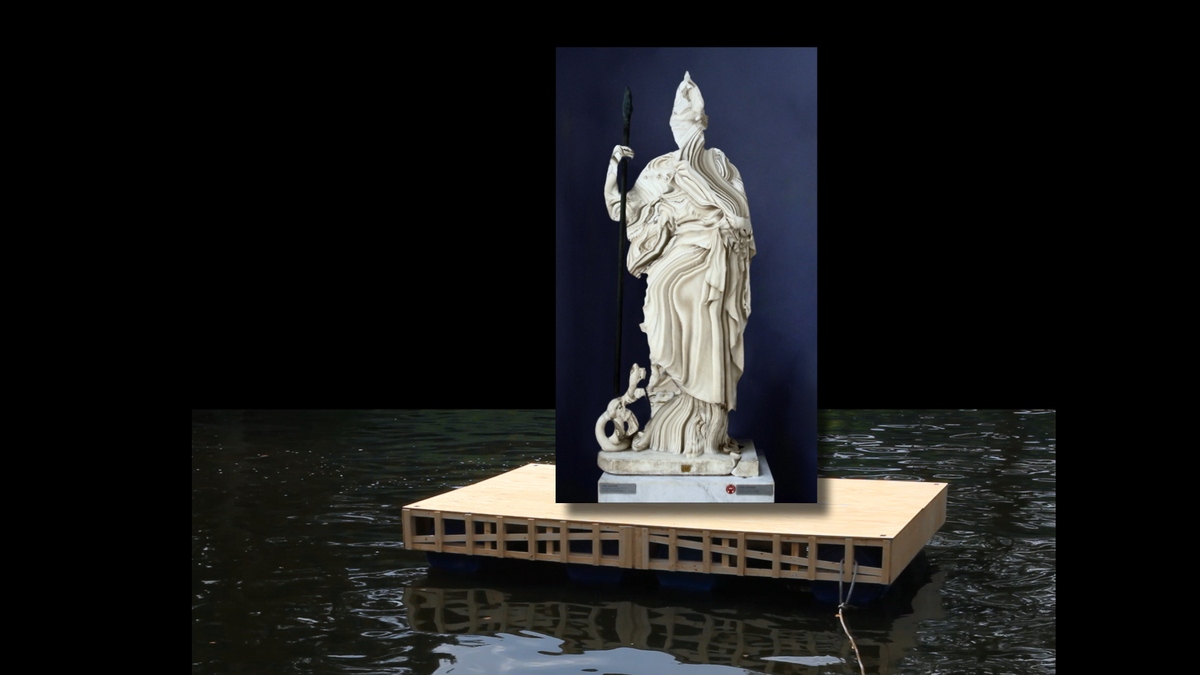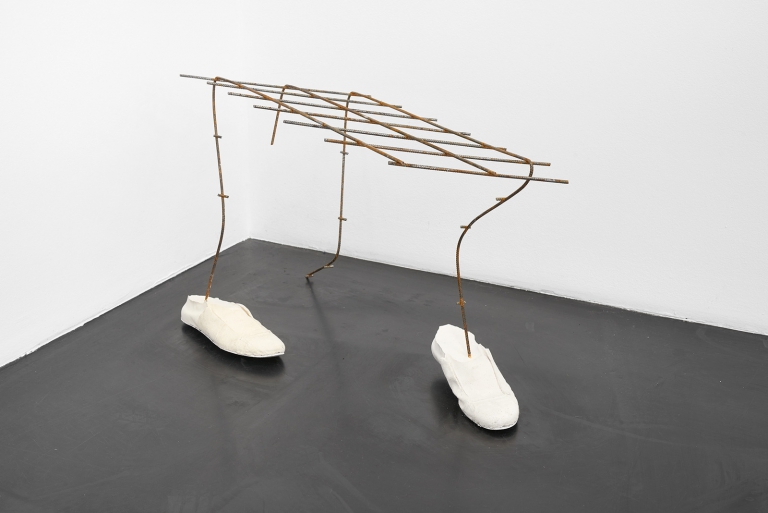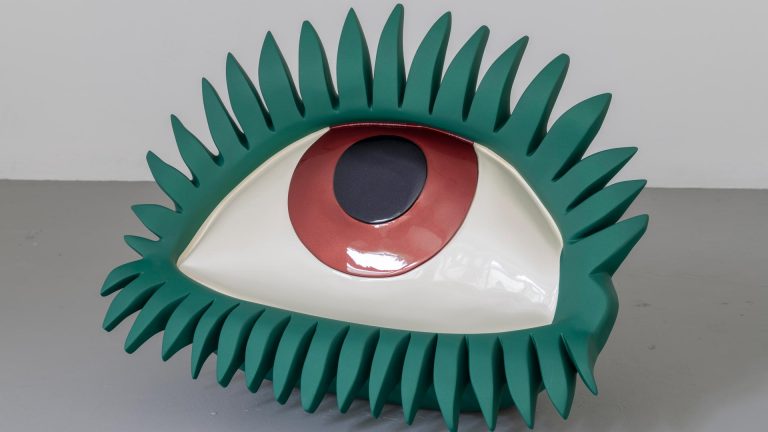Artist: Lorenzo Sandoval
Exhibition title: Deep Surface
Venue: L’Atelier-ksr, Berlin, Germany
Date: April 3 – May 7, 2016
Photography: all images copyright and courtesy of the artists and L’Atelier-ksr, Berlin
There is no distance or possible emancipation from the paradoxical multi-reality we live in, as there is no difference between private and public, immaterial and material, or virtual and physical anymore. They all melt and get mixed up in the global context, in which solid referents or models transform into viscous entities that make the task of moving on consistently difficult, forcing us to stay in permanent mobility, yet not going anywhere. The reason why we keep being precarious, following the spanish philosopher Santiago López Petit’s theories, is that we are perpetually mobilised. Nothing in our existence can escape mobilisation, which, ultimately, doesn’t lead anywhere but a loophole.
Metaphors are representations of the mind and thus impossible to escape. They are hypothetical cognitive symbols that depict the external reality and are, therefore, translations or even betrayals. López Petit uses the metaphor of gelling to depict a society where surface and depth blur and fluctuation is continuous: a society trapped between abandonment and dependence on a set of invisible but tight networks. The feeling of gelling serves to describe the paradoxical friction between abandonment and fastening; an in-between state that is neither liquid nor solid, never stops moving and can act upon events yet without changing them.
Viscous fluids like gel, which are the result of colliding particles moving at different velocities, need significant stressing in order to overcome the friction and move on. When particles of a fluid move at different velocities and collide, they form what we know as viscosity. The perpetual mobilisation in which we are currently stuck turns into a set of precarious conditions that eventually generate necessary systems supported by alternative forces. Those forces, such as affection and care, are what the immaterial economies are based upon.
Lorenzo Sandoval’s expansive projects are spatial storytellers and include the presence of other practitioners, which become almost equally valuable parts of a more complex whole.
In this new site-specific production he presents a body of work that responds to three stages: ‘Broken Parliament’, ‘Curriculum Vitae’ and ‘Deep Surface’. These structures reflect upon a set of elements within the different stages of art production and the parts that remain hidden in the process of showing final results; quasi-labour and hidden lapses, such as an economy of affection, the knot of precariousness, support and maintenance and “übermateriality”, as mentioned by Preciado when speaking about the unclear thresholds between material and immaterial work.
The thing to grasp here is not the unit but its process, which turns it into some kind of problematic; the matter of a society made out of fluctuant entities, coexisting through a gelling process. It is meant to unfold over the duration of the exhibition and serve as a proposition in order to renegotiate and reconstruct the common space while looking for common symbols and systems.
‘Broken Parliament’, 2016
The first stage of the project, titled ‘Broken Parliament’, is a modular display composed of a set of foldable chairs, sculptures, displays and flags with a veined effect on the surface of the furniture.
The veined pattern emulates the traditional techniques through which paper was printed in order to imitate marble. The technique consisted of paint floating over water. The flags, which are made out of neopren, follow the same method as the veined furniture. Moreover, their abstract motifs have an effect of missing semiotics, not representing anything but the blob-like material – and transitory – state of society. In other words: the current lack of common symbols and solid referents. Nevertheless, the lack of symbols becomes a symbol itself. A sort of face of a faceless amorphous entity.
All those elements together loosely mimic the institutional structure of a parliament: a platform for represen- ting the multiples voices of the people. But who are the people? Who is the “we” and how can this “we” initiate a process of self-institutionalisation? In Michel Serres’ words, “it is the fluctuating moving back and forth of the ‘I’. The ‘I’ in the game is a token exchange, and the “we” is made out of the ‘bursts and occultations of the I’. “We” is a group of “I” realizing some activities with a common purpose, at a specific moment. And the objects involved in this process are the quasi-objects (1).
A parliament is the place to talk and to decide in reaction to an absolute power or a single sovereign voice, in order to solve public affairs. Those voices shall be translated into one single narrative but we will not know whether the voices are translated or betrayed (2). In the eyes of Lopez Petit, there are no politics anymore, although everything is politicised. There is a need of politicising our lives as the representation in politics has turned into some sort of repetitive pantomime. Political speech is just performance, some betrayed message lost in translation.
‘Curriculum Vitae’, 2013 – on going
Objects perform as sensors, as they can record the surrounding gestures. They are testimonies of otherwise unseen situations, as well as triggers of connections and relationships between people, or what Michel Serres would call quasi-objects. In his book ‘The Parasite’ he explains this concept with the game of the furet:
The quasi-object is not an object, but it is one nevertheless, since it is not a subject, since it is in the world; it is also a quasi-subject, since it marks or designates a subject who, without it, would not be a subject. He who is not discovered with the furet in his hand is anonymous, part of a monotonous chain where he remains undistinguished. He is not an individual; he is not recognised, discovered, cut; he is of the chain and in the chain. He runs, like the furet, in the collective. The thread in his hands is our simple relation, the absence of the furet; ITS PATH MAKES OUR INDIVISION. Who are we? Those who pass the furet; those who don’t have it. This quasi-object, when being passed, makes the collective; if it stops, it makes the individual. If discovered, he is ‘it’. […] The moving furet weaves the ‘we’, the collective; if it stops, it marks the ‘I’. (3)
The second stage of the exhibition depicts a gallery of objects, displayed on the modules of ‘Broken Parliament’. The articles were collected from art-related side-jobs Sandoval carried out over the years, besides his own artistic practice, like assisting or supporting other artists, art handling and installing exhibitions. These leftovers act like sensors, recording gestures over time, invisible otherwise. Those gestures stayed inscribed on the materials the objects are made of.
Sandoval’s collection of “sensors” with indexical capacities represents the ones that would usually remain hidden due to their lack of importance. They are materialisations of an invisible labour, in addition to gestures such as care, maintenance and support. Those stay inscribed on their outcomes, which act as a “split-object shifting between subjugation and subjectification”, or what Joshua Simon calls “unready-mades”.(4)
Referring to Francesco Finizio’s theories, Simon explains that objects are the current serfs of a pseudo feudal debt economy based regime, where we humans are the lords. There is an enormous interdependency between those contemporary serfs and ourselves. We need to care for the wellness of our credit cards and mortgages (modem, phone, blow-dryer, television set, laptop, and boiler) in order to get their benefits and maintain our standard of living. That means, these objects trigger our actions the way Serres describes a ball triggering the movements of the players in a game. (5)
In addition, to seek self-realisation in our lives, to keep the desire alive and nourish our individuality and soul seem to be priority demands. The other side of this material feudalism is what Silvia Federici calls “immaterial” and “affective labour” referring to labour that doesn’t produce physical objects, and/or that is generated by the instrumentalisation of our own emotions and subjectivities. Those flexible structures are discreet but crucial when it comes to the realisation of things/projects, they are a sort of gooey matter that sticks everything together. (6)
‘Deep Surface’, 2016
Finally, the exhibited piece ‘Deep Surface’ serves as a formal link between the two other works, ‘Curriculum Vitae’ and ‘Broken Parliament’. It is a spatial essay in the form of a film that narrates the process over several years of three projects. The essence of these projects – which turn around the lack of solid referents and models in our current neoliberal capitalist society – is contained in the footage and flows to the tune of experimental composer Jörg Maria Zeger.
Not lacking anecdotic facts, Lauren Reid’s voice-over unravels three art projects that act as continuations of one another. In-between those projects, the objects turning and moving in circles act as a sole transcription of those processes, oscillating like ocean waves, or rather like whirlpools. The objects in motion belong to the work ‘Curriculum Vitae’, also part of the show. Those objects act as metaphors, making visible an economy supported by structures made of immaterial and affective labour.
The three self-contained parts of the narration in motion are sorted in three segments, named as ‘movements’ – referring to classical music compositions, where the parts are also wholes. The journey starts in 2009 with a project about photographic prints on ice, inspired by Talbot’s primitive silver-nitrate systems: the first photogra- phic technique that would enable putting the copies in circulation and distributing them. At the same time it acknowledges the possibility of ephemeral formats’ circulation, almost in a premonitory fashion.
The second movement consists of a 16mm film with footage of the Soviet memorial at Treptower Park in Berlin, filmed with the assistance of artist Sam Smith. An additional layer is added to the footage and the monuments get covered with rectangles, in which some veined paint flows and the former motif is replaced by an abstract veined effect – the same technique applied to ‘Broken Parliament’. The Soviet icon is hidden behind a digitally added layer, after an iconoclast gesture suggesting that the place’s meaning is lost and the monuments, turned into touristic attractions, project nothing other than hermetism. Hence, the digital interacts with the analogue while mediating this overlapping of temporalities and forms, in a manifestation of a total lack of symbols and referents, and their replacement by amorphous substances.
The third and last movement is a small introduction of a spatial storytelling project realised in the summer of 2015 at the Berlin Landwehr canal. ‘A Soft Tragedy’ splits the story, distributing the voices through different actors on a raft like the Medusa’s, in order to acknowledge the potential of some precarious structures, such as the actual raft, which was created using Italian designer Enzo Mari’s shelves system. The image of ‘The Raft of the Medusa’ by Théodore Géricault (1818–1819) appears in the footage with it’s characters blurred. The narration is disrupted as the shapes of the characters melt with one another like a fleshy machine, vibrating and oscillating back and forth in a baffled dynamic.
Those three individual, but interdependent works – ‘Broken Parliament’, ‘Curriculum Vitae’ and ‘Deep Surface’ – fluctuate back and forth, like waves, opening a conversation between form and functionality, and between surface and depth, and creating the illusion of a continuous quasi-liquid flowing in a close circuit, thus staying at the same spot. A blurb, depicting the substance from which our current post-capitalist society is built, due to the absence of definitive models that have been replaced by amorphous entities, such as blurred gooey figures that stick everything together and prevent fluid movement. In order for the acceleration to produce an effective movement in the substance, a one-directional pressure is needed, such as a straw blow.
– Gabriela Acha.
(1) SERRES, Michel, ‘The Parasite’, Hachette, Paris, 1997.
(2) LATOUR, Bruno, ‘We have never been modern’, Harvard University Press Cambridge, Massachusetts, 1993. (3) SERRES, Michel, ‘The Parasite’ Hachette, Paris, 1997.
(4) SIMON, Joshua, ‘Neomaterialism’, Sternberg Press, Berlin, 2013.
(5) Ibid cit.; (6) FEDERICI, Silvia, ‘Revolution at Point Zero – housework, reproduction and feminist struggle’ PM Press [Common Notions], Oakland, 2012.
Lorenzo Sandoval, Broken Parliament, 2016, Curriculum Vitae, 2016
Lorenzo Sandoval, Broken Parliament, 2016, Curriculum Vitae, 2016
Lorenzo Sandoval, Curriculum Vitae, 2016
Lorenzo Sandoval, Curriculum Vitae, 2016
Lorenzo Sandoval, Curriculum Vitae, 2016 (detail)
Lorenzo Sandoval, Curriculum Vitae, 2016 (detail)
Lorenzo Sandoval, Curriculum Vitae, 2016 (detail)
Lorenzo Sandoval, Curriculum Vitae, 2016 (detail)
Lorenzo Sandoval, Curriculum Vitae, 2016 (detail)
Lorenzo Sandoval, Curriculum Vitae, 2016 (detail)
Lorenzo Sandoval, Curriculum Vitae, 2016 (detail)
Lorenzo Sandoval, Curriculum Vitae, 2016 (detail)
Lorenzo Sandoval, Curriculum Vitae, 2016 (detail)
Lorenzo Sandoval, Curriculum Vitae, 2016 (detail)
Lorenzo Sandoval, Broken Parliament, 2016
Lorenzo Sandoval, Broken Parliament, 2016
Lorenzo Sandoval, Curriculum Vitae, 2016
Lorenzo Sandoval, Deep Surface, 2009-2016
Lorenzo Sandoval, Deep Surface, 2009-2016 (still from video)
Lorenzo Sandoval, Deep Surface, 2009-2016 (still from video)
Lorenzo Sandoval, Deep Surface, 2009-2016 (still from video)
Lorenzo Sandoval, Deep Surface, 2009-2016 (still from video)
Lorenzo Sandoval, Deep Surface, 2009-2016 (still from video)
Lorenzo Sandoval, Deep Surface, 2009-2016 (still from video)
Lorenzo Sandoval, Deep Surface, 2009-2016 (still from video)





















